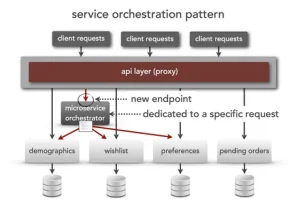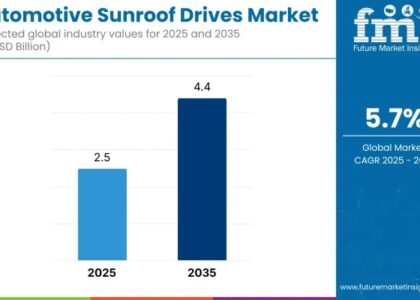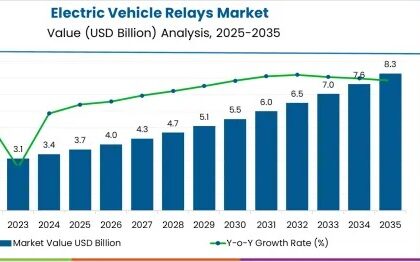
The global microservices orchestration market is set to experience exponential expansion between 2025 and 2035, largely fueled by the rapid adoption of cloud-native infrastructures and the growing demand for scalable, modular application development across enterprises. The market, valued at USD 1,730.1 million in 2025, is projected to surge to USD 7,967.4 million by 2035, registering an impressive compound annual growth rate (CAGR) of 16.5% throughout the forecast period. As businesses transition from monolithic architectures to microservices-based environments, orchestration has emerged as a critical component in managing service dependencies, communication flows, and deployment strategies within complex application ecosystems. Enterprises are increasingly leveraging orchestration platforms to automate workflows, ensure service reliability, and enable continuous delivery and deployment practices.
The rise of DevOps culture and agile software methodologies is further accelerating the deployment of orchestration tools, particularly in sectors such as finance, retail, healthcare, and telecom, where rapid innovation and continuous integration are imperative. Orchestration enables seamless coordination among distributed microservices, streamlining business operations and minimizing downtime. Cloud service providers are also playing a significant role in this growth by offering native orchestration frameworks that integrate easily with Kubernetes, Docker Swarm, and other container orchestration systems. Moreover, orchestration frameworks provide enhanced observability, scalability, and resilience—features that are becoming indispensable in today’s fast-paced digital economy. The growing demand for real-time data processing, fault-tolerant architectures, and multi-cloud support is reinforcing the strategic relevance of microservices orchestration in modern IT environments.
Elevate Your Strategy with Our Exclusive Report: Request Your Sample Now!
https://www.futuremarketinsights.com/reports/sample/rep-gb-17564
Key Takeaways
The microservices orchestration market is on a trajectory to exceed USD 7.9 billion by 2035, propelled by the shift towards modular, cloud-based software architectures and the necessity for robust application lifecycle management. Organizations are moving beyond simple container management and increasingly adopting orchestration tools that allow for dynamic scheduling, load balancing, service discovery, and automated recovery. Orchestration is now viewed as a cornerstone of enterprise digital transformation, enhancing operational efficiency and enabling the agile delivery of complex, multi-component applications. With increasing adoption across both large enterprises and small-to-medium businesses, the market presents robust opportunities for innovation and platform consolidation.
Emerging Trends in the Global Market
One of the most notable trends in the microservices orchestration market is the growing popularity of Kubernetes as a de facto standard for orchestration across public, private, and hybrid cloud environments. Kubernetes-based platforms offer extensive support for containerized workloads, facilitating horizontal scaling, automated rollouts, and rollback capabilities, which are essential for modern software delivery pipelines. Another prominent trend is the emergence of serverless orchestration frameworks, which eliminate the need for managing underlying infrastructure while providing event-driven coordination of microservices. This model is gaining traction in industries looking for operational simplicity and cost-effectiveness.
Additionally, integration with service meshes such as Istio and Linkerd is enhancing the observability, security, and traffic management capabilities of orchestration systems. These integrations are empowering enterprises with advanced monitoring, fault isolation, and service-level management features. There is also a growing emphasis on AI-driven orchestration platforms that utilize machine learning algorithms to predict service failures, optimize resource allocation, and automate remediation processes. Moreover, the focus on compliance and governance in highly regulated sectors is driving the development of orchestration solutions with built-in security, policy enforcement, and audit capabilities.
Significant Developments and Opportunities in the Global Sector
The microservices orchestration market is undergoing dynamic evolution, driven by technological advances and strategic investments. Major cloud providers like Amazon Web Services, Microsoft Azure, and Google Cloud Platform are expanding their orchestration capabilities with managed Kubernetes services, enhancing ease of use and scalability for developers. Enterprises are increasingly adopting orchestration to support complex event processing, continuous integration/continuous deployment (CI/CD) pipelines, and edge computing scenarios. The combination of orchestration and edge computing is opening new opportunities for real-time analytics, smart device management, and low-latency application delivery in sectors like manufacturing, automotive, and healthcare.
Opportunities also exist in the realm of data orchestration, where businesses need to manage data pipelines across diverse services and environments. As applications become more data-centric, the integration of microservices orchestration with data flow management tools is becoming critical to ensure consistency, quality, and compliance. Another area of significant opportunity is the orchestration of multi-tenant SaaS platforms, which require precise coordination of user-specific microservices, access controls, and billing systems. Vendors that offer flexible, customizable orchestration frameworks tailored to specific industry requirements are well-positioned to capture market share and drive future growth.
Recent Developments in the Market
Recent developments in the microservices orchestration market include the introduction of low-code orchestration platforms that allow developers and business users to design and manage workflows with minimal coding effort. These platforms are accelerating innovation by democratizing access to orchestration tools and reducing dependency on specialized DevOps resources. Another noteworthy development is the evolution of policy-driven orchestration, where platforms enforce rules related to deployment timing, resource limits, and compliance constraints automatically, thereby minimizing manual intervention and risk.
Several vendors have announced support for cross-cluster and cross-region orchestration, enabling global application distribution with localized failover and compliance controls. There is also increased focus on observability enhancements, with orchestration platforms integrating natively with distributed tracing, log aggregation, and metrics visualization tools to provide end-to-end visibility into application performance. In response to growing security concerns, vendors are embedding advanced encryption, identity management, and runtime threat detection capabilities into their orchestration systems to safeguard microservices against evolving threats.
Thorough Market Evaluation: Full Report
https://www.futuremarketinsights.com/reports/microservices-orchestration-market
Competition Outlook
The microservices orchestration market is highly competitive, featuring a mix of established technology providers, cloud hyperscalers, and emerging startups. Key players include Amazon Web Services, Microsoft Corporation, Google LLC, IBM Corporation, Red Hat (a subsidiary of IBM), Oracle Corporation, Docker Inc., VMware Inc., HashiCorp, and Cisco Systems. These companies are focusing on product innovation, cloud-native integration, and global partnerships to strengthen their orchestration offerings and enhance customer engagement. Many players are also investing in open-source technologies and community-driven initiatives to build scalable and interoperable orchestration solutions.
Key Segmentations
In terms of segmentation, the market can be divided by deployment model, including on-premise and cloud-based orchestration; by component, covering platforms and services; by enterprise size, spanning small and medium-sized enterprises and large enterprises; and by end-use industry, which includes BFSI, IT and telecom, healthcare, manufacturing, retail, and government. Among these, the cloud-based segment is expected to witness the highest growth, owing to its scalability, flexibility, and lower total cost of ownership. Meanwhile, industries like BFSI and healthcare are leading adopters, driven by the need for secure, scalable, and compliant application environments.
About Future Market Insights (FMI)
Future Market Insights, Inc. (ESOMAR certified, recipient of the Stevie Award, and a member of the Greater New York Chamber of Commerce) offers profound insights into the driving factors that are boosting demand in the market. FMI stands as the leading global provider of market intelligence, advisory services, consulting, and events for the Packaging, Food and Beverage, Consumer Technology, Healthcare, Industrial, and Chemicals markets. With a vast team of 400 analysts worldwide, FMI provides global, regional, and local expertise on diverse domains and industry trends across more than 110 countries.
Contact Us:
Future Market Insights Inc.
Christiana Corporate, 200 Continental Drive,
Suite 401, Newark, Delaware – 19713, USA
T: +1-845-579-5705
For Sales Enquiries: sales@futuremarketinsights.com
Website: https://www.futuremarketinsights.com
LinkedIn| Twitter| Blogs | YouTube




